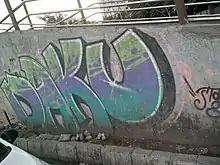Daku (artist)
Daku is a pseudonymous graffiti artist from Delhi, India.[1][2] Active since 2008, he painted art in several cities of India.
Daku | |
|---|---|
 Graffiti of Daku on footbridge in Goregaon, Mumbai | |
| Born | Real name: unknown Date of birth: unknown Birthplace: unknown |
| Known for | Graffiti Street art Social commentary |
| Website | www |
Early life
The real identity of Daku is not known. Not much is known about his life. He is possibly born around 1984. He was raised in a small town in Saurashtra, Gujarat. He studied art and worked with an advertising agency before starting graffiti. Daku literally means "bandit" or "dacoit" in Hindi.[1][3][4]
Career
[The street art is] decorative, contextual, layered and artists aren’t afraid of giving their name. Graffiti is more underground, more rebel.
— Daku, Wall Street Journal, 2013
He was introduced to graffiti in 2006 through a website called Streetfiles. His initial collaboration was with France-based artist JonOne, one of the founder-members of Crew 156 — the group of popular New York City Subway artists from the 1980s, in Mumbai in 2008 for a year.[5] He also collaborated with two other graffiti artist, Bond and Zine in Delhi in 2008. He started tagging his own name in Devnagari script on walls in Mumbai and South Delhi in 2008 and told that he did it to reach large Indian population who understand only local languages. He stenciled fuck in Hindi across nine places in Mumbai overnight in 2011 to protest against Vasant Dhoble, assistant commissioner of police who was accused of moral policing.[6] He regularly commented on social issues by his works like stenciled LPG cylinder rocket to highlight price rise, blindfolded protester during 2011 Indian anti-corruption movement.[7] Before 2010 Commonwealth Games in Delhi, he modified several stop signs to deliver messages and provoke reaction from public. He tagged many garbage bins with Ku Da in Delhi, an anagram of his own name. For years he tags his name Daku across cities in India in indigenous fonts and typography including Mumbai, Delhi, Ahmedabad and Baroda. He along with others, did 200-meter-long (660 ft) and seventy-four-meter-high (243 ft) wall graffiti, commissioned at Buddh International Circuit. He along with Bond, created 200 square meter graffiti at IIT Bombay TechFest in 2011.[1][4][8][9] Before 2014 Indian general election, he painted a graffiti Mat Do at F-block, Connaught Place which had dual meaning, don’t give vote or vote. It showed a fisted hand with an inked middle finger.[10]
Daku has created street arts with light, shadows and reflections. He first experimented during Kochi biennale, 2012 and put mirrors to reflect texts such as “Time Flies” or “Time Travel” for limited time in a day. He installed a shadow art in Lodhi Colony, Delhi in March 2016.[5][11]
He organized India's first-ever street art festival in Delhi in 2013.[12] His works have been showcased at venues such as the Centre Pompidou, Venice Biennale and Triennale Design museum.[13] He participated in the India Art Fair 2015 and created 100-meter-long stencilled mural on asphalt with the repeated slogan, This is commissioned vandalism.[14][15][16][17] He designed a room in flat of Hrithik Roshan in 2015.[18] He had done graffiti on shutters of Hysteria, the music merchandise shop, on Church Street, Bengaluru in late 2015 for "Mohan Kaun?" Project.[19] He placed billboards across Hyderabad in April, 2016 in criticism of consumerism.[5][20] In October 2016, he pasted giant snail posters across Silicon Valley, Bangaluru to highlight traffic jams.[21]
References
- Singh, Isha (27 April 2013). "Meet India's Banksy". WSJ. Retrieved 16 February 2015.
- "Pretty as a picture: India Art Fair 2015". The Sunday Guardian. 9 August 2015. Retrieved 9 August 2015.
- "'India's Banksy' wants to provoke voters". BBC News. 7 April 2014. Retrieved 16 February 2015.
- Bordewekar, Sandhya (29 November 2014). "Graffiti Art: The Emergence of Daku on Indian Streets". Retrieved 16 February 2015.
- Parakala, Vangmayi (2016-05-06). "On 15 May, this art will disappear". Live Mint. Retrieved 2017-05-31.
- Praveen, Priyanka (2016-11-11). "The dacoit of the art world". Deccan Chronicle. Archived from the original on 2017-08-04. Retrieved 2017-08-04.
- Nevatia, Shreevatsa (7 November 2014). "Rinky on the wall". The Hindu Business Line. Retrieved 9 August 2015.
- "Cans & Roses: Guerrilla artists on Indian street". The Economic Times. 18 August 2012. Retrieved 16 February 2015.
- "Street art breathes a new life into Mumbai — Latest News & Updates at Daily News & Analysis". dna. 7 December 2014. Retrieved 9 August 2015.
- "A pithy message on the wall". Deccan Herald. 25 March 2015. Retrieved 9 August 2015.
- Roshni Majumdar. "Graffiti powered by the sun. What?!". CNN. Retrieved 2017-05-31.
- "A new breed of artists is taking their canvases to public spaces". India Today. 19 March 2013. Retrieved 16 February 2015.
- "St+ART Delhi 2015". St+ART Delhi 2015. 4 November 2014. Archived from the original on 16 February 2015. Retrieved 16 February 2015.
- Khurana, Chanpreet (22 January 2015). "Giant ants, melting carpets". livemint.com. Retrieved 9 August 2015.
- Kuruvilla, Elizabeth (10 January 2015). "Girish Shahane: 'Art as investment is a dreadful idea'". livemint.com. Retrieved 9 August 2015.
- Maddox, Georgina (30 January 2015). "Alive to the arts". The Hindu Business Line. Retrieved 9 August 2015.
- Shahane, Girish (31 January 2015). "The Ideas That Shaped The Special Projects At The India Art Fair". The Huffington Post. Retrieved 9 August 2015.
- Mirror, Mumbai (14 May 2015). "Reflects action". Mumbai Mirror. Retrieved 9 August 2015.
- "How did Bengaluru's Church Street go from being food, drink central to a hub of art, and often, activism? Here's how - Bangalore Mirror -". Bangalore Mirror. Retrieved 2017-05-31.
- "The dacoit of the art world". Asian Age. 2016-11-13. Retrieved 2017-05-31.
- Thomas, Maria. "India's most famous graffiti artist is sticking giant snails around Bengaluru". Quartz. Retrieved 2017-05-31.